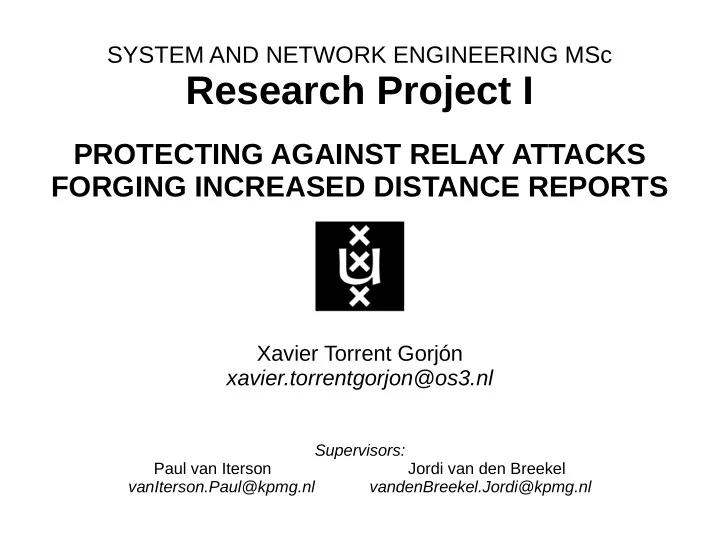

SYSTEM AND NETWORK ENGINEERING MSc Research Project I PROTECTING AGAINST RELAY ATTACKS FORGING INCREASED DISTANCE REPORTS Xavier Torrent Gorjón xavier.torrentgorjon@os3.nl Supervisors: Paul van Iterson Jordi van den Breekel vanIterson.Paul@kpmg.nl vandenBreekel.Jordi@kpmg.nl
Summary ● Distance-bounding protocols ● Feasibility of the attack: study cases – Autonomous Cars – Drone MANETs (Mobile Ad-Hoc NETworks) ● Limitations of other systems ● Preventing increased distance reports – Behavior verification – Multiple distance-bounding signals – Distributed knowledge ● Conclusions
Summary ● Distance-bounding protocols ● Feasibility of the attack: study cases – Autonomous Cars – Drone MANETs (Mobile Ad-Hoc NETworks) ● Limitations of other systems ● Preventing increased distance reports – Behavior verification – Multiple distance-bounding signals – Distributed knowledge ● Conclusions
Distance-bounding protocols ● With the current implementations, closer distances cannot be faked. – Proof through physical limitations : cannot go faster than the speed of light. – Need for a shared nonce and a fast processing time. Challenge channel: 1 bit Response channel 1: 1 bit Response channel 2: 1 bit Figure 1: Distance-bounding protocol. Each challenge bit is answered with two bits: one in the communication and another one in the form of channel selection.
Distance-bounding protocols ● Current implementations can be used to prevent a wide range of attacks that attempt to fake decreased distance reports, generally on Access Control Systems. Figure 2: Distance-bounding protocols can be used to protect Passive Key Entry Systems (PKES).
Distance-bounding protocols ● However, current distance-bounding protocols do not prevent increased distance reports. – Physical limitations cannot be used. – This leads to our research questions: ● Study the feasibility of relay attacks forging increased distance reports. ● How can these relay attacks be prevented.
Summary ● Distance-bounding protocols ● Feasibility of the attack: study cases – Autonomous Cars – Drone MANETs (Mobile Ad-Hoc NETworks) ● Limitations of other systems ● Preventing increased distance reports – Behavior verification – Multiple distance-bounding signals – Distributed knowledge ● Conclusions
Feasibility of the attack: study cases ● Autonomous Cars – If two cars believe they are further away than they really are, they might crash. – Other systems might prevent this, but distance- bounding protocols could be an additional safety measure. Figure 3: An early design of a fully autonomous car by Google.
Feasibility of the attack: study cases ● Drone MANETs I: Autonomous delivery service – To save costs, multiple drones could be used to carry large packages. – Tempering the distance awareness of these drones might cause them to lose equilibrium and fall. Figure 4: A delivery drone by Amazon.
Feasibility of the attack: study cases ● Drone MANETs II: Area surveillance – Drones can be used to check areas for multiple purposes: military operations, updating maps, searching for lost people... – Erroneous distance reports can lead to leave areas unexplored.
Summary ● Distance-bounding protocols ● Feasibility of the attack: study cases – Autonomous Cars – Drone MANETs (Mobile Ad-Hoc NETworks) ● Limitations of other systems ● Preventing increased distance reports – Behavior verification – Multiple distance-bounding signals – Distributed knowledge ● Conclusions
Limitations of other systems ● It could be argued that distance-bounding protocols were not made for this purpose. ● However, other location systems present difficulties as well.
Limitations of other systems ● GPS location ● Radar detection ● Inertial Navigation System
Limitations of other systems ● GPS location – Can be disrupted – Sometimes not reliable even in non-dangerous environments. Figure 5: GPS requires unobstructed line of sight with satellites to work. This limits its usability inside buildings or underground.
Limitations of other systems ● Radar detection – Systems could attempt to physically detect attackers – Problem: stealth technology surpasses anti-stealth technology in the current state of the art Figure 5: The US F117 is a 13m wide airplane, but under the radar it appears to have the same size as a bird.
Limitations of other systems ● Inertial navigation system – Fits perfectly our purpose, but it cannot be reliably used as a stand-alone positioning system due its accuracy. This may change in the future. Figure 6: An Inertial Navigation System used by the French army.
Summary ● Distance-bounding protocols ● Feasibility of the attack: study cases – Autonomous Cars – Drone MANETs (Mobile Ad-Hoc NETworks) ● Limitations of other systems ● Preventing increased distance reports – Behavior verification – Multiple distance-bounding signals – Distributed knowledge ● Conclusions
Preventing increased distance reports ● Behavior verification – Similar idea to Intruder Detection System on networking environments. – Attempt to detect sudden changes in the received data, such as signal strength or large variations on the reported locations.
Preventing increased distance reports ● Multiple distance-bounding signals – Original distance-bounding only attempts to check if a reporter is inside or outside a certain range. – Use multiple distance-bounding signals to obtain approximate location, not only distance. Figure 7: Multiple signals difficult attacks on the system, as attackers need to coherently fake multiple distances. However, distance in a straight line is still easy to fake.
Preventing increased distance reports ● Distributed knowledge – Instead of relying only on its own measurement, a node could also ask for the measurements of other nodes. – It would be extremely difficult for an attacker to fake multiple different distances at the same time.
Summary ● Distance-bounding protocols ● Feasibility of the attack: study cases – Autonomous Cars – Drone MANETs (Mobile Ad-Hoc NETworks) ● Limitations of other systems ● Preventing increased distance reports – Behavior verification – Multiple distance-bounding signals – Distributed knowledge ● Conclusions
Conclusions ● Most of the systems discussed are not employed nowadays but they are a latent problem . ● Lower-distance bound cannot rely on physical limitations for its security: difficult to achieve perfect security . ● Proposed solutions -specially a combination of them- reduce the changes of performing an attack without the system noticing it.
Questions?
Recommend
More recommend